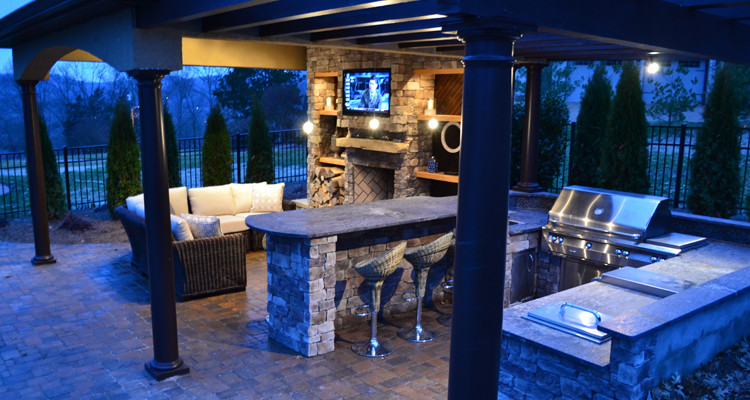Kitchens are the undisputed heart of every American home. Typically where everyone tends to gather, mingle, and lingers during gatherings. To achieve this outdoors means to extend your living space outdoors. Entertaining and keeping your family and friends entertained requires more than sitting out a table and a few uncomfortable chairs.
Having an outdoor kitchen gives you the ability to prepare meals and be around your guest with minimal time running back and forth inside. When planning your outdoor kitchen, take into consideration the size of your family and what type of entertaining you intend to do. Whether its cooking for the kids after ball games on the weekends or having family and friends over for the big game or both. Ask yourself if you will need a full service satellite kitchen with refrigerator, sink, prepping station, multiple cooking stations, recessed burner, and serving areas, or just a grilling island with a cantilever bar sitting area. These are all items to think about when in the planning stages.
Since durability is such a critical component, choosing the right stone and countertop will make or break your Outdoor Kitchen experience. Veneered stone for the face of your Outdoor Kitchen is very affordable and increasingly durable while a more natural stone may be more costly, but can be very aesthetically pleasing and long lasting with minimal maintenance. When choosing between the selection of countertop material be aware of your options and what olds up best against the elements. Here are a few (in my personal opinion) in order from favorites to less favorites; 1. Granite – Granite is a great Outdoor Kitchen countertop. With the ease of maintenance and not that susceptible to staining unless neglected and/or stains left on the surface overnight. With normal clean-up, Granite countertops will look great for years of enjoyment. Concrete Countertops are very durable, but may scratch or knick a bit easier than granite. In general will hold up well. One of the cons with concrete that it may tend to fade from the original color and turn to a yellowish hue. I would suggest using light colors and seal with a penetrating sealer yearly to help protect. Porcelain Tile is also very durable and can withstand the outdoor elements. The con is that the grout lines tend to become dirty and hard to care for. Again protect your new tile with a good sealer. Stone is widely used and holds up well against the normal wear and use. I recommend using thick 1 ½” minimum preferably 2” thick stone for this application. This will help reduce the shale off the surface. Other material used is slate and soapstone.



